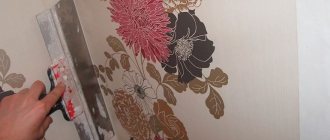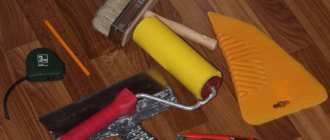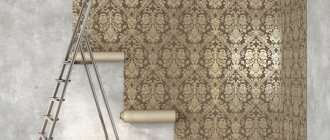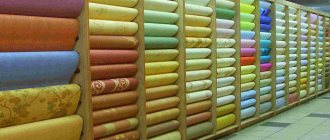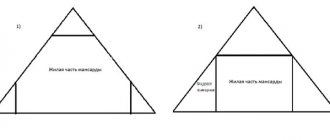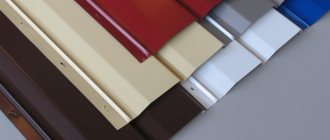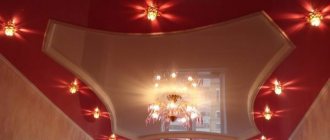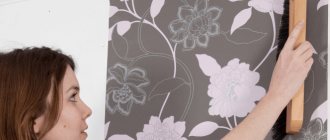And despite the fact that for many domestic people this finishing material is a curiosity, it is used more and more often. With the help of meter-long wallpaper, it is possible to achieve a greater width of stripes, reducing the number of seams. This gives aesthetics and allows you to save effort and time to achieve a neat result.
The width of standard rolls is 53 cm. The width of meter rolls is 1 m. Abroad, 70-100 cm of coating is most common today. They are offered in different lengths and designs.
Advantages
Meter wallpaper is very easy to use if you know the technique of applying it. However, in practice, a number of problems may initially arise with the support of one party. To do this, it is better to hire an assistant who will level the coating and support it during the gluing process.
A meter wide coating has a number of advantages:
- Gluing wide vinyl wallpaper is easier because fewer pieces are needed.
- Less time is spent on work due, again, to less materials.
- No noticeable joints. There are few of them and each one can be given more attention. It is easy to achieve a seamless effect when the wall looks completely covered.
- The cost of one meter roll with a length of 10 meters is lower than the price of two rolls of 53 cm.
If you evaluate the material from the point of view of design choice, then there may not be many colors and decorative variations, but most of them are modern and stylish.
A little about wide wallpapers
The name of this wallpaper speaks for itself. Their main difference is their increased width. Unlike standard half-meter or meter ones, they are often used for gluing large areas. Nowadays, meter-long non-woven wallpaper is not very uncommon on the market. And many manufacturers provide a large selection of meter-long wallpaper based on different materials, as well as in a wide color spectrum.
Speaking of non-woven wallpaper, regardless of its size, it is tested for compliance with the state standard. Thus, they can be different in structure and facial finish.
Flaws
Sometimes people do not understand how to properly glue meter-long vinyl wallpaper, because it is uncomfortable to hold in their hands and it is difficult to apply it perfectly evenly to the wall. It is important to take into account the subtleties of technology.
The disadvantage is the need to especially carefully prepare the surface, since any unevenness and curvature on a smooth, seamless fabric can stand out.
If a small fold appears in some place, again, due to the slight unevenness of the walls, this will cause deformation across the entire width of the strip. To avoid this, you can make a horizontal cut at the problem point, but the method does not always solve the problem. If there is significant curvature, you can simply move the canvas - it will “ride along the wall” for 10 minutes until the glue sets.
Covering walls with wide meter-long vinyl wallpaper is more difficult when working in a room with high ceilings. Usually, the help of one more person is required - the first one holds one edge, the other applies the adhesive composition and applies the canvas. In principle, two people can also quickly deal with narrow wallpaper.
Pros and cons of wide wallpapers
The most important advantage of wide wallpaper is the smaller number of joints.
You can also glue them much faster, because you have to cut fewer pieces. In terms of price, buying wide wallpaper will be much cheaper. If you go to a hardware store and look at the price tag, you will see that it is more profitable to buy one wide roll than two narrow ones. But wide wallpapers have a drawback. One strip may not be enough to cover the wall, and you will have to buy an extra expensive roll. If you glue wallpaper in a corridor where there are many corners, it will also be difficult to work with. There will be a lot of trimming, which will result in a lot of waste. Another difficulty is that it is very difficult for one person to glue them. It is very difficult to hold them and apply them alone. If the apartment has uneven walls, it will be problematic to glue it evenly without “bubbles.”
Therefore, before repairing, you need to decide what wallpaper to buy and paste.
Materials and accessories
To ensure that wide vinyl wallpaper can be hung correctly and accurately, you need to prepare the following materials:
- primer;
- glue that is suitable for working with vinyl wallpaper;
- a roller made of rubber;
- ruler at least 1 meter;
- large width brush for convenience;
- sharp legs;
- scissors;
- plumb and level;
- pencil;
- clean cloth that can be cut and used as rags.
It is very important to choose the right adhesive suitable for use in repairs. If you buy the wrong product, a problem will arise the next time you try to remove the wallpaper, when another cosmetic repair is required.
Gluing wide vinyl wallpaper is easy and quick, having all the equipment at hand.
Conclusion
Now you know about all the advantages and disadvantages that wide wallpaper has, and you can choose the optimal solution and carry out the gluing work correctly. The video in this article will help you understand the topic even better, and if you don’t understand something, ask in the comments.
Wide wallpaper: roll dimensions, advantages and disadvantages, gluing technology
Wide wallpapers for walls are quite popular today. However, for many, such dimensions of trellises are unusual.
And therefore it is worth talking separately about their advantages, disadvantages and gluing nuances.
Meter-long trellises require a special approach
Preparing the walls
How to properly glue meter-long vinyl wallpaper? It is important to start work by preparing the surface of the walls. This stage consists of the following actions:
- The old coating is removed from the walls - paint, wallpaper, etc. You cannot leave excess old fabric, even if it seems that it has been firmly applied and does not play a special role. You can remove old wallpaper by punching holes and rubbing it with water. The paint is removed with a spatula. Make sure that when working with sharp objects there are no “scars” left on the wall.
- You can stick wide meter-long vinyl wallpaper after applying a primer. Sometimes it is replaced with low-quality glue diluted with water. This procedure will improve the adhesion of the material and the wall surface.
- If you plan to install foam borders around the perimeter of the room, this must be done before you start treating the walls with glue and, of course, applying wallpaper.
- From the curb or ceiling you need to measure the length of the wall. This will determine how to cut the strip. When the size is selected, and it is better to extend it by 3-5 cm, they begin to apply the composition on top.
- Marking is being done. To do this, use a ruler or level and a pencil. It is better to stop at the level - it is long and will help determine the presence of a slope that should not exist.
Once the markings have been made and the strips have been cut, you can begin application.
Step-by-step instructions for hanging wallpaper of increased width
- Preparation of the working surface;
- Remove all sockets and switches from the wall.
- Thin the glue. First read the instructions on the correct dilution technology, and before purchasing, make sure that the adhesive is compatible with the material of the canvas.
- First, use a plumb line to find the vertical. For convenience, you can make marks with a pencil directly on the wall. Use it as a guide when gluing.
- The canvas should have an overlap from the ceiling and floor of 5 to 10 centimeters. Keep this in mind when cutting.
- The first panel is glued at the window, and then clockwise or counterclockwise, depending on the direction of the light. When gluing, follow the pattern or parts of the patterns, if any. So, before gluing, carefully check the sequence.
- When gluing in corners, you must use a cut strip. You need to lower the first panel about 2 centimeters at the corner. Then, in turn, the same overlap is made on the adjacent fabric. When the blade is in contact with the corner, you can cut the top layer.
- After gluing, get rid of air bubbles, adjust the panels until completely smooth.
Pasting
How to glue meter-long vinyl wallpaper? Let's look at the detailed instructions:
- Prepare the glue. Apply the material to the area of the wall where you plan to apply the first sheet of wallpaper.
- We start from the top, following the marked lines. When gluing one side, pay attention to the position of the other corner - it should be rotated.
- Use a plastic spatula or roller to go over the surface well. This will help get rid of excess air and remove gaps.
- Extra centimeters of wallpaper are cut off either with a knife or a metal spatula. To do this, the unnecessary piece is folded and cut along the marked line so that it remains outside the working area. If you can't make a cut, the wallpaper is probably still damp. You need to wait until it dries completely.
If we are talking about using non-woven wallpaper, then the work will be simple. The material can be moved for 10 minutes until the glue dries. This will avoid defects and make the joints perfect.
By the way, quick-drying glue should be avoided. It is often offered in a low quality option, but even if you are confident in the source of your purchase, it is still a more difficult product to work with.
If you plan to overlap, there should be an extra 2-3 cm of material on one side.
How to hang non-standard wallpaper alone
Despite the fact that everyone believes that wide wallpaper should only be glued with an assistant, this work can be done alone. The average width of the rolls is 106 cm, and the arm span is 150 cm. Based on this, we can say that it is quite possible to level and join seams.
Even if everything didn’t work out right away, you can always remove the canvas, coat the wall again and reapply the canvas, but at the same time take into account the mistakes made. It is very important that all operations for gluing wide wallpaper must be performed in enclosed spaces, in which all possible drafts are excluded. Windows and doors may be opened only one day after completion of work.
Working with problem areas
How to hang meter-long vinyl wallpaper if the place of work is problematic? What is a problem area anyway? We are talking about the corners, the place behind the battery, above the window opening, the doorway.
It is easier to glue wide meter-long vinyl wallpaper if the areas to be used were cut from one roll. Then the combination happens better. The most difficult thing is to select several pieces to create an inconspicuous pattern, carefully executed.
You can also work with meter-long wallpaper on the ceiling. The application technique is simple, but your hands will get sore, because holding wide sheets and gluing them at the same time is not always easy.
We looked at how to properly glue wide vinyl wallpaper and settled on one simple technique. In general, all activities will proceed quickly and without problems if there is someone to help. If an assistant cannot be found, a lot of effort can be expended.
It is convenient to glue meter-wide vinyl wallpaper, and the coating itself usually looks stylish, interesting, and can be perfectly combined with other designs, including tiles, panels, stone (natural and artificial), wood, etc.
Drying time for different types of wallpaper
Different types of coatings dry at different speeds, some require 24 hours, while others require 2-3 days. Do not forget that until the walls are completely dry, you cannot open the windows to prevent drafts. Otherwise, bubbles may appear on the surface.
Vinyl sheets will dry in two days if the room temperature is 16°-30°C and the humidity does not exceed 60%. In other cases, the drying period will be longer. Very dense and heavy types of vinyl wallpaper with a three-dimensional pattern can take about a week to dry.
The drying time for paper webs ranges from 19 to 73 hours. Vinyl sheets on a paper base dry in 17 hours, on paper-vinyl sheets - from 24 hours, and vinyl non-woven sheets - from 47 hours.
Important! Under no circumstances should you try to reduce the drying time artificially by heating; this process can spoil the design and distort the joints. Wallpaper can withstand cold or high humidity more easily than sudden temperature changes and air flows.
If you have to glue alone
You can undertake such a process only if the wallpaper was purchased on a non-woven basis, because such models are considered the densest and most durable. Even after applying the adhesive base to the strip, it does not get too wet, and mechanical damage is minimized.
There are also rarely problems with seams, the workpieces are perfectly stretched on a wet plane and possible excesses in the form of air chambers or wrinkles are easily removed. If a piece of trellis is placed incorrectly, it can be torn off and reapplied without any damage or tearing.
Preparatory activities
Preparing the room and walls is an important stage of work:
- The old coating is removed. You need to pay special attention to this and do everything carefully to avoid problems in the future. If the wall is damaged, you will have to putty, and this will require additional time and financial costs.
2. Old wallpaper comes off better after wetting. You need to irrigate them with water and leave them for a while. This option is not suitable for waterproof materials. In this case, you will have to work hard with a spatula.
3. After removing the coating, you should inspect the entire wall for defects, which must then be corrected. Unreliable plaster is replaced with new one.
4. It will be easier to glue wallpaper if the wall is primed in several layers. It will be easier to glue wallpaper on a smooth surface.
Reference! If you need to prime the wall, you can save money by preparing the solution yourself. To do this, you need to take 10 liters of water for a couple of glasses of PVA. The ingredients are mixed and applied to the wall. Wallpaper should be glued after the primer has dried.
After preparing the surface, strips should be cut. You can measure the required length with a tape measure by calculating the distance from the floor to the baseboards. Then, following the instructions, glue is prepared. First you need to lubricate the walls, then the stripes, setting them aside for a while to soak.
Before gluing wallpaper, you need to determine where to start - from the door or window. This has its own nuances, which we will consider a little later. There are several different techniques that will be better suited in certain conditions.
Marking walls and cutting canvases
Understanding the intricacies of the question of how to hang wide wallpaper yourself, one cannot underestimate the importance of applying auxiliary marks for the first sheet. Such markings will help to position the workpiece perfectly evenly on the wall, after which the remaining strips will lie end to end and create an attractive cladding with invisible seams, as well as a beautiful, natural pattern.
When cutting a roll into pieces, it is important to provide a margin; experts advise leaving at least 5 cm, preferably more. It’s easy to trim off the excess, but a shortage will cause a lot of frustration. To prepare the pieces, you need to roll out the tube on a clean floor, then bend the paper to fit the size; this bend can be easily cut with a knife; a cutter with replaceable blades is popular.
Useful tips
- Before purchasing meter-long non-woven wallpaper, you need to calculate how many rolls you need to buy. To do this, calculate the height and width of the walls of the room. For example, if the height of the wall is 2.8 meters, then one roll of wide canvases will be enough for 3 meters of wall width, given that one roll contains 10 meters of material.
- When working, you should not skimp on the adhesive composition. If the strip is glued unevenly, then thanks to the abundant layer of glue, the canvas will slide well, which will help align it, instead of peeling off and redoing the work again.
- To prevent wrinkles from appearing after gluing, it is necessary to smooth the canvas with a soft cloth or roller immediately when it is transferred to the wall.
Meter
If the widest meter-long wallpaper was chosen, then it will be the most difficult to glue it. The following tips can make the process easier :
- Nothing can be determined “by eye”. Always take accurate measurements and count the exact number of stripes.
- The easiest way to start gluing is from the window, marking a vertical line for orientation.
- When gluing wallpaper in a corner, it is best to leave an overlap at the corner. It’s better to let part of the strip overlap with the next one, but there won’t be the slightest gap.
- It is best to glue not alone, but with at least one assistant.
- There is no need to try to stretch the strip horizontally. As a result, after drying, it will narrow back and leave a noticeable gap on the wall.
- In a wide strip, you can easily miss an air bubble, so you need to carefully iron the pasted sheet several times, moving from the middle to the edges.
- Usually the last strip is too wide for the remaining space, and it has to be cut off vertically as well.
- You can cut off the remaining wallpaper from the wall only after it has completely dried. Otherwise, the strip may begin to shrink, forming wrinkles on the strip itself and cracks near the edges, which are unlikely to be masked (how to remove folds if the wallpaper wrinkles?).
Features and types
Vinyl wallpaper is a finishing material that consists of two layers at once:
- The bottom layer is made of non-woven fabric, paper or fabric.
- The top layer consists of polyvinyl chloride, a stronger and more durable material. This layer is often decorated with patterns and textured embossing.
This type of wallpaper is divided into several subtypes:
- Textured, which can imitate embossed materials, such as plaster or textiles.
- Smooth or flat wallpaper. This type includes embossed and silk-screened.
- Compacted glossy wallpaper - with better protection from moisture and temperature changes.
When selecting wallpaper, the following features should be taken into account::
- If the texture of the material is very porous, then it will be difficult to remove dust and dirt from it, and in the case of the kitchen, grease (how to clean wallpaper from dirt?).
- Roll sizes can be different - from 50 centimeters to 1 meter. This should be taken into account when choosing, because the smaller the width, the more convenient the finishing process will be, especially in small rooms.
- The more defects and unevenness there are on the wall, the thicker the wallpaper material should be - this way it will hide all the imperfections (how to level the walls for wallpaper?). Thin wallpaper is only suitable for smooth walls.
- If the color of the material is monochromatic, then any dirt will stand out strongly on it. Therefore, wallpaper with a pattern is more suitable for the kitchen and similar rooms (how to choose the right wallpaper for the kitchen?).
- Before purchasing, you need to measure the dimensions of the room and buy extra material (read how to calculate wallpaper by area and perimeter of the room here).
